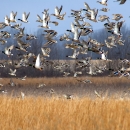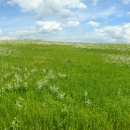What We Do
Wildlife conservation is at the heart of the National Wildlife Refuge System. It drives everything on U.S. Fish and Wildlife Service lands and waters managed within the Refuge System, from the purposes for which a national wildlife refuge national wildlife refuge
A national wildlife refuge is typically a contiguous area of land and water managed by the U.S. Fish and Wildlife Service for the conservation and, where appropriate, restoration of fish, wildlife and plant resources and their habitats for the benefit of present and future generations of Americans.
Learn more about national wildlife refuge is established to the recreational activities offered to the resource management tools used. Using science to support management activities, the Refuge System staff manage Service lands and waters to help ensure the survival of native wildlife species.
The management goal of the U.S. Fish and Wildlife Service within the Rainwater Basin is to restore, as much as possible, the natural hydrologic and ecological function of wetlands for the benefit of migratory birds and resident wildlife. For the grasslands, our goal is to reestablish and maintain native grassland communities.
In order to accomplish these management goals, the Wetland Management District utilizes multiple land management practices including high intensity grazing, water pumping, prescribed burning, haying and native plant re-seeding. Management activities also include tree removal, invasive species invasive species
An invasive species is any plant or animal that has spread or been introduced into a new area where they are, or could, cause harm to the environment, economy, or human, animal, or plant health. Their unwelcome presence can destroy ecosystems and cost millions of dollars.
Learn more about invasive species control, sediment removal from wetlands and filling irrigation pits.
Management and Conservation
Refuges deploy a host of scientifically sound management tools to address biological challenges. These tools span active water management to striving to maintain the character of wilderness, all aimed at ensuring a balanced conservation approach to benefit both wildlife and people. At this field station, our conservation toolbox includes:
- Planning - Comprehensive Conservation Plan
- Planning - Habitat Management Plan
- Habitat Restoration
- Agriculture
- Climate Resilience
- Conservation Easements
- Cultural Resources
- Education & Outreach
- Fire Management
- Grazing
- Human Dimensions
- Invasive Species Management
- Inventory and Monitoring
- Land Acquisition
- Law Enforcement
- Integrated Pest Management
- Recreation Management
- Species Research
- Water Management
Our Services
At this field station we offer the following public services:
- Candidate Conservation Agreements
- Cooperative Agriculture Agreements
- Habitat Planning and Management
- Landowner Incentives for Habitat Improvements
- Photo Blinds
- Research - Special Use Permit
- Commercial Photography - Special Use Permit
- Recreation
Law Enforcement
U.S. Fish and Wildlife Service law enforcement officers have a wide variety of duties and responsibilities. Officers help visitors understand and obey wildlife protection laws. They work closely with state and local government offices to enforce federal, state and refuge hunting regulations that protect migratory birds and other game species from illegal take and preserve legitimate hunting opportunities. Some other duties include patrolling closed areas or Wilderness areas, maintaining relationships with neighboring landowners, maintaining refuge boundaries, and participating in public events related to wetland management district wetland management district
A wetland management district is a U.S. Fish and Wildlife Service office that manages waterfowl production areas in one or more counties. Waterfowl production areas are small natural wetlands and grasslands that provide breeding, resting and nesting habitat for waterfowl, shorebirds, grassland birds and other wildlife. The Fish and Wildlife Service acquires waterfowl production areas under the authority of the Migratory Bird Hunting and Conservation Stamp Act, primarily using funds from the sale of Federal Duck Stamps. The Refuge System’s 38 wetland management districts comprise thousands of waterfowl production areas – almost all in the Prairie Pothole Region of the Northern Great Plains.
Learn more about wetland management district issues.
Law enforcement issues should be referred to the refuge manager.
You may also report violations to FWS TIPS line at 1-844-FWS-TIPS (1-844-397-8477).
Laws and Regulations
There are lots of fun, interesting, and educational things you can do and enjoy in the Rainwater Basin Wetland Management District. When in doubt about rules or regulations regarding a specific activity, please check with the Rainwater Basin Wetland Management District office at 308-263-3000 before participating in that activity. Be safe and have fun!

